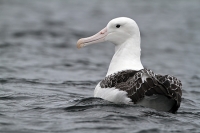Southern Royal Albatross killed by Sea Lion

by Stefan Pfützke & Katherine Lee
Southern Royal Albatrosses Diomedea [epomophora] epomophora breed exclusively on Subantarctic islands south of New Zealand, especially on Campbell Island which holds 99% of the total breeding population, and within the Auckland Island group. In the late 1990s 8,200-8,600 pairs were estimated to breed annually on Campbell which is equivalent to c. 28,000-29,500 mature individuals (Croxall & Gales 1998, Moore et al. 1997, Shirihai 2008).
Human predation, farming and introduced mammals were some of the reasons for the decline of Southern Royal Albatross, but since the 1930s, the population is thought to be recovering.
Nevertheless fishing presumably continues to have an impact on the population. A possible decrease in the population during the 1970s to early 1980s coincided with the peak in long-line fishing in the New Zealand region. Although this albatross population is now considered stable or to be possibly even increasing, it is still highly susceptible to human impacts and due to its very restricted breeding range also to stochastic effects. Therefore the taxon is classified as “vulnerable†in the IUCN red list of threatened species.
The major breeding colonies of New Zealand Sea Lion Phocarctos hookeri are located within the Auckland Island group, but a small breeding colony is also found on Campbell Island. In the 19th century sea lions were killed in large numbers by pelt-hunters but since their protection in the late 1880s the population has recovered (Gales 1995). However, a recent estimate suggests that the total population may be smaller than 12,000 individuals and declining.
Sea lions feed near the shore and are generally opportunistic predators. Food mostly consists of a wide variety of fishes and cephalopods with squid obviously being an important prey for New Zealand Sea Lions in the Subantarctic region, but penguins and various other sea birds are also taken occasionally (more details).
It was on a recent trip on board the expedition vessel "Spirit of Enderby", that we observed the killing of a Southern Royal Albatross by a sea lion. In the morning of 9th November, we came across an obviously recently fledged young bird at Perseverance Harbour on Campbell Island that seemed unable to take flight due to the lack of wind as the bay was on the lee side of the Northern hills. From the distance is was clear that the young albatross was being harassed by a few Giant Petrels Macronectes spec. as well as some Black-backed Larus dominicanus and more than a dozen Red-billed Gulls L. scopulinus. In fact, a closer view from our Zodiacs revealed that the bird was seriously attacked by what appeared to be a male New Zealand Sea Lion. The sea lion attacked the albatross from below and bit off parts of the albatross' abdomen. The gulls and giant petrels joined the attack on the albatross, feeding on what was available. The albatross defended itself, fought back and was able to grab with its bill whatever was trying to attack it, usually the gulls as they were the smallest in size, then repeatedly slapping the bird onto the water. Nevertheless the albatross became weaker and weaker, keeping afloat with increasing difficulty so that the gulls escaped from the albatross' attacks more easily. Eventually, the sea lion snatched the whole albatross, similarly slapping the bird on the water surface until the bird was left floating helplessly on its back before dying. After about 15 minutes the sea lion had left the scene Giant petrels and gulls returned to the lifeless body to feed on the carcass.
Another recently fledged Southern Royal Albatross was seen swimming a few hundred metres apart and similarly seemed unable to take off from the water. Unfortunately we lost that bird, but, in the afternoon, after landing on Campbell Island a second albatross, presumably the second bird seen in the morning, was also attacked and lost its life in the same way as the other albatross.
Since New Zealand Sea Lions are opportunistic feeders young albatrosses can be an additional source of food that is easily available when young birds learn to fly. In a similar manner fledglings of Black-footed Albatross Phoebastria nigripes fall prey to Tiger Sharks Galeocerdo cuvier on Hawaii which is well documented on videos. In the waters surrounding Midway Island obviously only inexperienced juvenile birds are in danger of such attacks and it is estimated that nearly 10% of all albatross fledglings are killed this way (more details). Nothing is known however about the impact of New Zealand Sea Lions on numbers of Southern Royal Albatross fledglings. Possibly only single sea lions have learned that young albatrosses are an easy prey and have specialized on such a feeding habit, so the effect might be marginal. But, given the relatively small albatross population and the fact that two such incidents were observed within half a day it is also feasible that a substantial number of fledglings is regularly killed by sea lions.
References:
CROXALL, J. P.; GALES, R. (1998): "Assessment of the conservation status of albatrosses". In ROBERTSON, G.& GALES, R.: Albatross biology and conservation. Chipping Norton, Australia: Surrey Beatty & Sons.
MOORE, P. J., SCOTT, J. J., JOYCE, L. J. AND PEART, M. (1997): Southern Royal Albatross Diomedea epomophora epomophora census on Campbell Island, 4 January-6 February 1996, and a review of population figures. Science and Research Series No.101. Wellington, New Zealand:Department of Conservation.
SHIRIHAI, H. (2008): The complete guide to Antarctic wildlife (2nd edn). Princeton University Press: Princeton and Oxford.



















